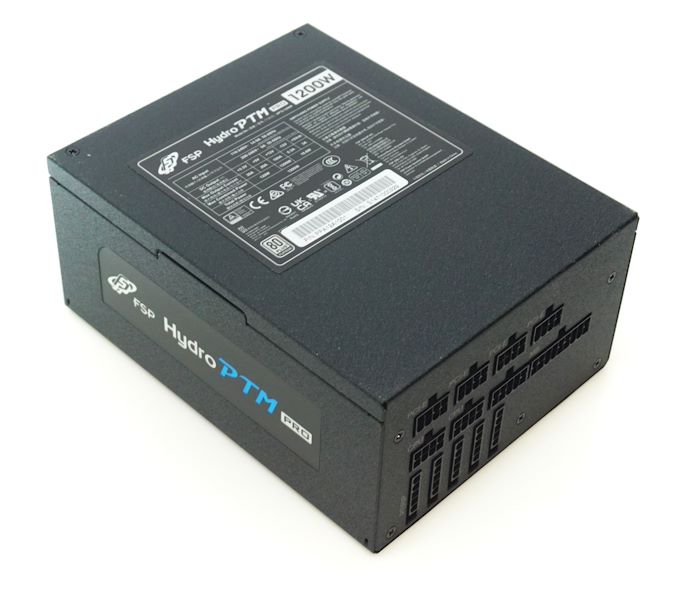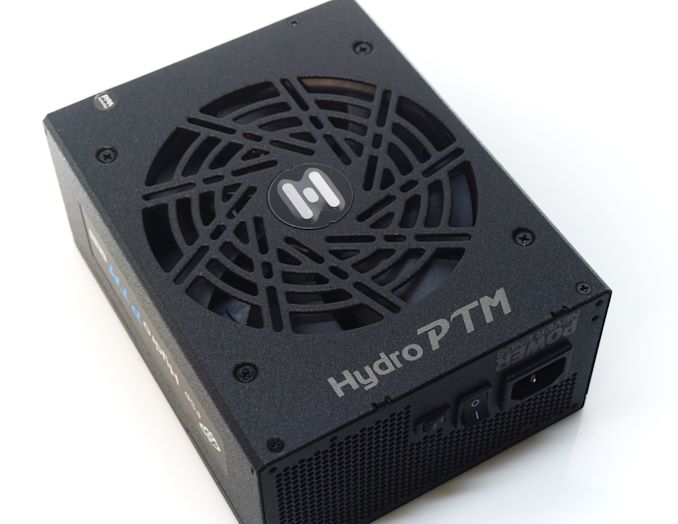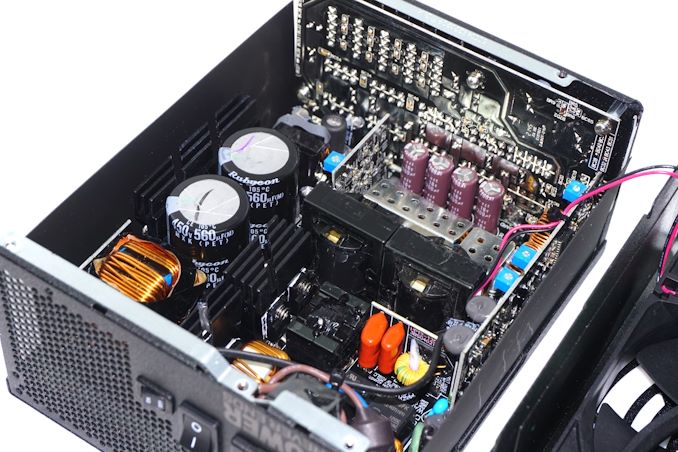The FSP Hydro PTM Pro 1200W PSU Review: Improving on the Tried and True
by E. Fylladitakis on April 20, 2022 8:30 AM EST- Posted in
- Cases/Cooling/PSUs
- PSUs
- 1200W
- FSP
- 80Plus Platinum
- Modular
Power Supply Quality
As part of our testing, we also check output parameters are within specifications, as well as voltage ripple and line noise.
| Main Output | ||||||||
| Load (Watts) | 243.15 W | 607.24 W | 904.47 W | 1202.96 W | ||||
| Load (Percent) | 20.26% | 50.6% | 75.37% | 100.25% | ||||
| Amperes | Volts | Amperes | Volts | Amperes | Volts | Amperes | Volts | |
| 3.3 V | 1.87 | 3.44 | 4.68 | 3.42 | 7.01 | 3.4 | 9.35 | 3.38 |
| 5 V | 1.87 | 5.12 | 4.68 | 5.11 | 7.01 | 5.04 | 9.35 | 5.04 |
| 12 V | 18.71 | 12.14 | 46.77 | 12.13 | 70.15 | 12.05 | 93.53 | 12.02 |
| Line | Regulation (20% to 100% load) |
Voltage Ripple (mV) | |||||
| 20% Load | 50% Load | 75% Load | 100% Load | CL1 12V |
CL2 3.3V + 5V |
||
| 3.3V | 1.7% | 12 | 16 | 20 | 28 | 14 | 16 |
| 5V | 1.5% | 10 | 10 | 12 | 16 | 8 | 12 |
| 12V | 1% | 12 | 16 | 18 | 20 | 20 | 16 |
The electrical performance of the FSP Hydro PTM Pro 1200W PSU is excellent overall. Our instruments recorded a maximum ripple of 20 mV on the 12V line, a mere sixth of the 120 mV recommended design limit and an outstanding figure for a PSU with that kind of power output.
The filtering on the 3.3V and 5V lines is good, with a maximum of 28 mV and 16 mV on the 3.3V and 5V lines respectively. The unusual part here is that the filtering on the 5V line is significantly better than that of the 3.3V line, which is a reasonable design choice considering that the 3.3V line is barely used anymore, but it is not a typical design practice. Voltage regulation is very good on the 12V, holding at 1.0% across the nominal load range. The regulation of the 3.3V and 5V lines is slightly inferior, at about 1.6% across the load range.
Conclusion
FSP developed the Hydro PTM Pro as a successor to the Aurum PT, in an effort to compete with the newer, more advanced PSU platforms from other manufacturers. The 1200W unit that we tested today is the most powerful of the series but the company also has 1000W and 850W versions of the same platform available – all of which are just as large too. FSP also is the OEM behind the creation of the platform, therefore we expect to see the same base design filter down into other products as well.
It can be said without a doubt that FSP focused most of their design and marketing efforts on quality. Both externally and internally, the Hydro PTM Pro is built like a tank. FSP did not cut any corners and used only top-quality parts for the creation of the Hydro PTM Pro, down to secondary circuitry and components. This, of course, includes the cooling fan - the Protechnic Electric is a rare sight in commercial PSUs for a reason, and that reason is its very high cost. The assembly job is outstanding, with a very clean layout and every part that could be somehow dislodged glued down. Even its paint is very difficult to scratch, as if the designer was expecting the PSU to be installed in a moving contraption. FSP covers the Hydro PTM Pro with a ten-year long warranty, among the longest in the market at this time.
The overall performance of the Hydro PTM Pro is very good but, honestly, we expected a bit more, especially from a company whose platform releases are few and far between. The Hydro PTM Pro is not significantly better than its predecessor, the Aurum PT, which was first released nearly a decade ago. It does offer substantially better power quality and it runs cool but, compared to its predecessor, its energy conversion efficiency practically remains about the same and sustains the same massive external proportions. We cannot help but feel that FSP could have done better by either reducing the length of the unit or improving its overall efficiency, although we have to admit that getting an efficiency certification above 80Plus Platinum is a tremendously challenging task.
In summary, the Hydro PTM Pro is meant to be an upgrade of the Aurum PT, yet few things have changed. The power quality of the Hydro PTM Pro undeniably is better and the unit runs cooler but, on the other hand, it retains its long chassis, is about just as efficient as its predecessor was, and can be pretty loud when stressed. It currently retails for about $270, which pits it directly against some significant and very capable competition. Regardless, the Hydro PTM Pro 1200W PSU unquestionably is a very good product that can easily become attractive if the retail price drops during a sale.













20 Comments
View All Comments
ballsystemlord - Thursday, April 21, 2022 - link
I'm assuming desktop HDDs "ramp-down" when not in use. So they'll then need to ramp-up when the system is running and the CPU+GPU is more loaded down.I can't really say if the various GPUs go to full power when first powered on, or if they go into an idle state. It's safer to assume a higher power draw than underestimate things IMHO.
dqniel - Friday, April 22, 2022 - link
Who uses 5 METERS of RGB strip in their PC? Even if you went with that crazy amount of RGB, a normal kit uses about 5 watts per meter. That's only ~25W, not 220W.Samus - Wednesday, April 20, 2022 - link
Someone mentioned this last time an FSP Hydro PSU was reviewed, and it still sticks out in my mind that naming an electronic power supply with a liquid acronym sends shivers down my spine :)meacupla - Wednesday, April 20, 2022 - link
hydro not only applies to water based fluids, but also oil based fluids. Like hydraulic systems typically use mineral oils with additives that reduce corrosion, and wear.Sivar - Wednesday, April 20, 2022 - link
To me, it implies "water cooled", like the EVGA FTW HYDRO series of graphics cards.This leads me to wonder: Why would a power supply need liquid (whether oil or water) cooling?
Slash3 - Wednesday, April 20, 2022 - link
FSP has actually produced a few water cooled versions (including a similar 1200W) over the years under the Hydro nameplate.https://www.anandtech.com/show/12411/fsp-liquid-co...
There have been a few others that have done so (Koolance, DeepCool, etc), but none of them were particularly popular for obvious reasons.
Oxford Guy - Thursday, April 21, 2022 - link
Is this all these companies can do now — use undersized heat sinks and blast the fan to compensate?The noise level is unacceptable. It’s bait and switch. Advertise a high wattage but make the product so loud for anything approaching that capacity as to make it worthless. This is just like the UPS that claims sine wave output but which is incapable of actual sine waves above 25% output.
Scams upon scams upon scams. It’s extremely tiresome.
meacupla - Thursday, April 21, 2022 - link
If you stick in an oversized heatsink, what you end up doing is killing all the airflow. Making heat pockets where the hot air doesn't get flushed out is worse, despite the extra cost from a bigger heatsink.flyingpants265 - Thursday, April 21, 2022 - link
I think you missed the point..m16 - Wednesday, May 18, 2022 - link
This is a really tempting PSU, provided its long term reliability is good.During this pandemic it has been hard to get higher power PSUs at a decent price, and while this is on the higher end of pricing, the specs sorta justify it.
I would get it in a heart beat if I can't get anything else as it future-proofs GPUs.